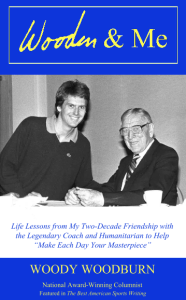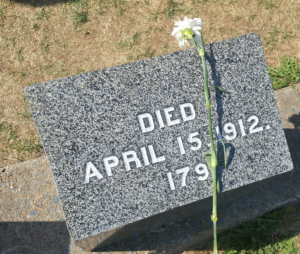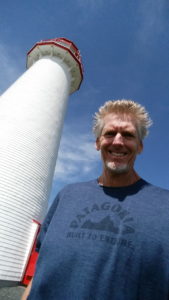Is your Club or Group looking for an inspiring guest speaker or do you want to host a book signing? . . . Contact Woody today!
* * *

 For a Personalized Autographed copy of “STRAWBERRIES IN WINTERTIME” or “WOODEN & ME” mail a check for $25 to:
For a Personalized Autographed copy of “STRAWBERRIES IN WINTERTIME” or “WOODEN & ME” mail a check for $25 to:
Woody Woodburn
400 Roosevelt Court
Ventura, CA 93003
* * *
Quaint Fishing Village’s Solemn History
Peggy’s Cove is a quaint fishing village with brightly painted cottages of yellow and red and blue on the south shore of St. Margarets Bay in Halifax, Nova Scotia.
Its charm is not without alarm. On the path nearing Peggy’s Point Lighthouse is a bronze plaque with a green patina of age and rogue sea: “Warning: Injury And Death Have Rewarded Careless Sight-Seers Here. The Ocean And Rocks Are Treacherous. Savour The Sea From A Distance.”

An idyllic calm inlet within the rough waters of Peggy’s Cove.
An even starker reminder of the ocean’s treacherousness came just a few miles away when my wife and I visited Fairview Lawn Cemetery. A wooden sign, white with blue lettering, offers solemn notice: “Titanic Grave Site.”
Rising up a grassy slope are three rows of grave markers where 121 victims of the infamous sea disaster are interred. They found their final resting places here because two ships based in Halifax – the Mackay-Bennett and the Minia – assisted the search for bodies.
Viewing downhill from the crest of the site an idyllic image comes into focus: meeting at a single gravestone at the top, the three rows of markers bow outward suggesting the contour of a ship’s hull.
The top marker, a waist-high granite pedestal, is inscribed: “Erected To The Memory Of An Unknown Child Whose Remains Were Recovered After The Disaster To The ‘Titanic’ April 15, 1912.”
In 2002, after forensic testing identified the unknown child, a smaller plaque was added: “Sidney Leslie Goodwin, Sept. 9, 1910 – April 15, 1912.”
Daily, something else is added: visitors leave memorial offerings. On this day they included crayons and coloring markers, a porcelain angel figurine, and two teddy bears.

An unidentified marker at the Titanic grave site.
Almost impossibly, a nearby grave pulls on one’s heartstring fivefold harder – for here rests Alma Paulsen and her four children, ages 8, 6, 4 and 2. It is claimed it took the 29-year-old mother so long to get her children dressed that they missed the lifeboats. It is also said she lovingly played the harmonica to soothe and distract them as the doomed ship sank.
Remarkably, the Fairview Lawn Cemetery also holds the remains of victims from another epic maritime calamity – the Great Halifax Disaster of 1917. Its death toll actually surpassed the Titanic’s by more than 200 with an estimated 1,950 instant casualties. An additional 9,000 were injured.
It happened on a December morning after two cargo ships collided in the Halifax Harbor. The initial damage was actually minor. However, one of the ships was carrying a full load of explosives for the war effort in Europe, including 400,000 pounds of TNT.
That disabled ship floated downstream and ran aground and caught fire. The ensuing explosion leveled a full square mile of Halifax. A half-ton chunk of the ship’s anchor still lies where it landed 2.5 miles away. Shockwaves shattered windows 50 miles in the distance.
It was, according to experts, the most-powerful man-made blast until the arrival of The Atomic Age.
Here is something else powerful: Americans, especially volunteers from Boston, rushed to Halifax’s aid. The city continues to send a 40-foot spruce tree to Beantown each Christmas season as a thank you.
A more significant thank you came in the aftermath of the September 11 terrorist attacks. After the U.S. closed its airspace, a total of 224 planes were diverted to Canada. Halifax, as well as other Canadian cities, opened shelters and provided food and comfort.
Our tour guide, a local resident, put it this way: “At the end of the day, it was our American neighbors coming to our rescue in 1917 – so when we had the chance, we did the same on 9-11.”
* * *
Woody Woodburn writes a weekly column for The Ventura County Star and can be contacted at WoodyWriter@gmail.com.
 Check out my memoir WOODEN & ME: Life Lessons from My Two-Decade Friendship with the Legendary Coach and Humanitarian to Help “Make Each Day Your Masterpiece” and my essay collection “Strawberries in Wintertime: Essays on Life, Love, and Laughter” …
Check out my memoir WOODEN & ME: Life Lessons from My Two-Decade Friendship with the Legendary Coach and Humanitarian to Help “Make Each Day Your Masterpiece” and my essay collection “Strawberries in Wintertime: Essays on Life, Love, and Laughter” …
- Personalized signed copies are available at WoodyWoodburn.com
- Unsigned paperbacks or Kindle ebook can be purchased here at Amazon

